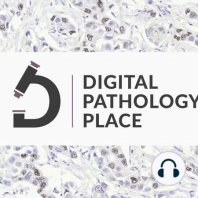30 min listen

Immuno-oncology 101 w/ Elfirede Nößner, HelmholzZentrum, Visiopharm advisor
Immuno-oncology 101 w/ Elfirede Nößner, HelmholzZentrum, Visiopharm advisor
ratings:
Length:
35 minutes
Released:
Sep 6, 2021
Format:
Podcast episode
Description
This episode is brought to you by VisiopharmCancer immunotherapy, aka immuno-oncology, is tapping into the power of our own immune system to fight cancer. There are multiple processes and immune cell populations involved in tumor immunology and digital pathology and whole slide imaging has allowed scientists to leverage the power of tissue image analysis to detect and quantify them.Today’s podcast guest, Prof. Elfriede Noessner will walk us through the complexities of the immune system, explain how it is being influenced to cure cancer and what role tissue image analysis plays in the process. In the course of her research she studied the following processes relevant for immuno-oncology together with the cells responsible for them:· Killing: T-cells· Removing the debris of the tumor: macrophages· Antigen presentation: dendritic cells· Antibody production: B-cells· Immune response regulation: regulatory T cells and checkpoints: CTLA4 and PD1/PDL1Killing is crucial for destroying the tumor, but without removing the debris of the killed cells the surrounding tissue will suffer. Antigen presentation enables the immune system to see the enemy. If we do not have antigen presentation, the T-cells responsible for the killing process are blind.Antibody production is an upcoming research area of immuno-oncology however the processes are not well understood yet. Regulation of the communication – stopping the immune response, prevents overshooting. In the body’s fight against the tumor, this regulation is coming too early, it stops the T-cells before killing all the tumor cells. This is detrimental in tumor oncology. The stopping proteins are called checkpoints (e.g., CTLA4, PD1/PDL1) and to keep the T-cell attack going on, they need to be inhibited. Seeing is believing, so visualizing the cells and checkpoints has a great convincing effect for the scientific community, but it is also crucial for evaluating the effectiveness of the immune system. It makes it possible to see if the immune cells are in the right location and in the right number. A great example of this proving that the numbers of T-cells in the tumor influence the patient prognosis more than the classical pathology grading is the Immunoscore® of colon cancer. Quantification with image analysis of the numbers and locations of T-cells in colon cancer patients changed the way colon cancer therapy was approached. This was a breakthrough proving that T-cells can matter. However, they do not work all the time and the task of the scientists is to figure out how to activate them. We need to understand what regulates the T-cells – one aspect is the checkpoints the other part is the regulatory cells. If the regulatory cells are close to the T-killer cells, the killer cells are inhibited. This can be only evaluated in an image – the proximity of the different cell types matters, and image analysis is the only way to accurately determine this information. The immune system is a complex entity, but in order to fight cancer, we need to understand and learn to influence it. Digital pathology and image analysis have become indispensable tools in this mission. Get your "Digital Pathology Beginners Guide" E-book for free! Sign up for the waiting list here.
Released:
Sep 6, 2021
Format:
Podcast episode
Titles in the series (89)
HistoWiz: fast histology and an image database for mining from Brooklyn NY w/ Ke Cheng by Digital Pathology Podcast